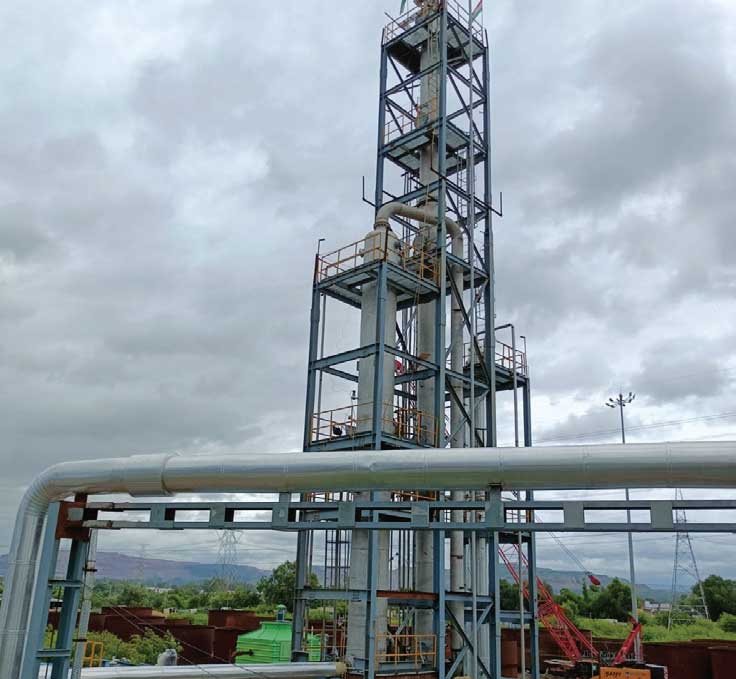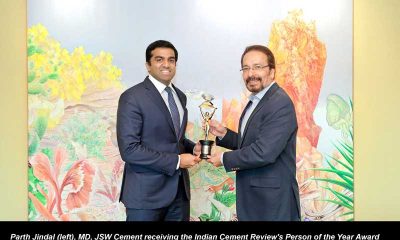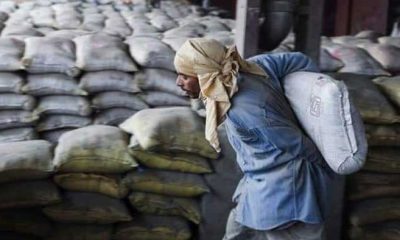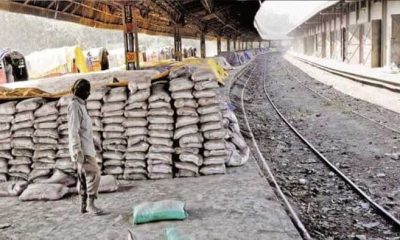Product development
Refractory Monoliths
Published
8 years agoon
By
admin
Refractory Monoliths are nothing but concrete that can withstand temperatures over 1,500?C. With better understanding of nano-materials, the present generation of castables space not only easy to use, but also lasts long says P. P. Vajifdar.
The word ?refractory? is derived from a Latin word that means ?stubborn?. Ideally, a refractory material needs to be stubborn to any change either in shape or size or its chemistry, in the face of high temperature and attacks by corrosive/abrasive solids, liquids or gases during the life-cycle of the product being produced.
To appreciate the importance of refractories, one needs to know that modern life cannot exist without refractories. There can be no metals, ferrous and non-ferrous, cements, fuel oils, petrochemicals, plastics, glass, fertilisers, ceramics and umpteen other items of daily use without refractories. The capital & replacement costs of refractories are very small as a percentage of total cost; but failure of refractories brings the entire plant to a standstill.
The earliest refractories were the cooking pots of clay used by the ancient civilisations of Egypt, Mesopotamia and the Indus Valley. As man discovered ores, he searched for better refractories to melt these to produce metals.
Initially through the industrial revolution in the 1700?s till the mid-twentieth century, refractories were predominantly pre- shaped and fired. Since shaped refractories required a laborious production cycle, these had to be ordered well in time and stocked; leading to higher inventory and longer delivery time. Today, the major industries consuming refractories are as shown in Fig. 1. The cement industry is the second major consumer, although a distant second from the steel industry.
Towards the 1960s, production of refractory cements of high purity gave birth to the first castables. These castables initially had properties inferior to shaped refractories; but still the convenience of using castables, these being much simpler to manufacture, and consequently lower lead time, led to a steady increase in sales. Towards the 1980s, nano particle refractory powders became available and low cement castables started becoming produced. Today refractory castables are plus 80 per cent of sales of all refractories, as shown in Fig.2 , and are technically superior to shaped refractories:
Chemistry Of Refractory Monoliths:
OPC technologists are familiar with the main phases of OPC clinker, namely, C2S, C3S, C3A, C4AF. The first 3 are hydraulic, contributing to various properties of concrete like early strength, etc. In case of refractory Alumina Cements too, various phases contribute to different properties of refractory concrete. (Legend C:CaO, S:SiO2, A: Al2O3, F: Fe2O3, H:H2O)
Alumina Cements
Alumina Cements are basically a binary product of the A12O3-CaO system. Tertiary products like Ghelinite, C2AS are present as unwanted phases due to presence of SiO2 in the lime or alumina raw material source.
These cements are the heart of conventional & low cement castables. They are manufactured by inter-grinding raw materials containing A12O3 & CaO, palletisation & sintering in a rotary kiln at temperatures ranging from 1300? to 1450?. There are essentially two types of cements manufactured, a low purity one & a high purity cement.
Conventional & Low Cement Castables
Before we study in some depth the products of hydration of high purity alumina cements, let us consider the essential features of conventional and low cement castables.
Conventional castables are very much like civil engineering concrete, essentially consisting of aggregates and cement. Low cement castables are similar to M-80 & M-120 grades concrete containing super plasticisers and nano particles.
Any one sized particle, loosely filled, will have as much as 40 per cent of porosity. Concrete or conventional castables are made up of different sized aggregates, the smaller sizes filling the inter-particle porosity, thus compacting the concrete. The finest particles 20-45 microns in fineness are obtained by grinding.
Even the best graded concretes could achieve up to 20 per cent porosity, thus limiting the strength of the cast concretes to 500 kg/cm2. This was due to the fact that the porosity caused by the finest particles could not be filled with micro-fine powders. It was only after the 1980s that nano particle (sub-micron) powders became available. Use of these led to further compaction in concretes bringing down the cast concretes? porosity to 12-14 per cent. Use of these nano particles reduced the flow of the concretes and necessitated the use of super plasticises to restore flow. Thus, dawned the era of superior concretes. This is better illustrated by Tables 2 & 3 and Figure 4.
Typical strength profiles of these 2 types of castables are better illustrated by Fig. 3;
Hydration of Alumina Cements and their influence on castable properties:
When alumina cements are produced, different phases are formed during pyro-processing. This is particularly dependent on impurities present in the raw materials and the firing temperature.
A careful look at above table reveals that the phases C2AS & C4AF are formed due to impurities like SiO2 & Fe2O3. They are to be avoided and being non-hydraulic do not contribute to strength of cement & concrete.
Presence of C12A7 makes the cement too fast setting. Conversely, presence of excessive amounts of CA2 makes the cement too slow setting.
The most useful phase is CA being of highest density and CCS, having a moderate setting time, and a high melting point.
On adding water to a castable, the main useful phase reacts with water and forms different hydrates depending on casting and curing conditions as given in Table 9 below. It must be understood that some hydrates are stable compounds, others being meta-stable, and the reactions are temperature dependent.
We shall discuss the significance of these properties a little later in the article. This paper is written for cement technologists and it would be pertinent to compare the setting time and heat of hydration of alumina cements & OPC.
It needs to be noted that alumina cements set slower than OPCs.
Basic difference between concretes made from OPC and refractory concretes is that the latter has to be heated up during service or before service. The hydrates, as given in table 10 above break up releasing water. Eg. CAH10 loses 53.5 per cent water while C3AH6 loses 28.6 per cent.
Conventional Castables
- In conventional castables, percentage of alumina cement varies between 15 to 25 per cent
- Since percentage of cement is high, heat of hydration is tremendous (Table 4)
- Setting time of alumina cements is slow (Table 5). To prevent premature dehydration, before strength can develop, temperature of curing is controlled to < 20? by using ice cold water for mixing.
- Since cement content is high, large quantities of CAH10 is formed. As CAH10 on heating up has 53.5 per cent water, large quantities of water will have to be expelled during heat-up of the castable.
- Heating rate needs to be controlled, to avoid explosive spalling.
- This large evaporation of water during heat-up explains the fall in strength of conventional castables at intermediate temperatures (Fig. 4).
Low Cement Castables
- In low & ultra-low cement castables, percentage of alumina cement varies between 1.5 to 6 per cent.
- Since percentage of cement is low, heat of hydration is much less.
- Since quantity of heat generated is less, increase in temperature is negligible.
- There is thus no need to limit temperature < 20?. In fact, high curing temperatures are necessary to give economic setting time.
- As temperature of curing > 35?, predominantly the hydrate formed during curing will be C3AH6
- Quantity of water expelled during heat-up will be only 28.6 per cent (Table 10). Heating rate still needs to be controlled, to avoid explosive spalling, due to very compact, closed structure. Here, even a small amount of steam can lead to explosive spalling.
- Heat-up of the low cement castable is aided by addition of organic fibres that char/melt below 100?, creating capillaries for safe escape of steam.
To summarise, careful gradation, low cement content, use of nano-particles, plasticisers, dispersants, set adjusters and additives that assist in safe burnout of water during heat-up, has produced a superman amongst refractory castables. This technology leap helped all industries that use refractories to replace cumbersome shaped products with easy to use castables. These had superior properties than the shaped refractories; but they suffered from poor thermal spalling resistance. Thus, cyclic industrial furnaces which are periodically heated and cooled avoided low cement castables.
Also low cement castables, had a hot MOR, only moderately higher than that of conventional castables (Table 3) The castables? only drawback is that it is supplied in two components. The CCS after drying is a low, just 250 kg/cm2; but this is only of academic interest, since the castable is used at high temperature where strength pick-up is excellent. Its Hot MOR is equal to that of shaped refractories; it has excellent spalling resistance. In fact this is possible, since CaO is eliminated from the matrix and the castable reduces to a two-component one: Al2O3-SiO2. Fig. 4 & 5 below illustrate this succinctly.
Some Key applications of Castables in Cement Plants
Burner Lance is a critical area with specific needs. Strong thermal loads, abrasions, infiltrations and chemical attacks must be considered. Coupled with this a constricted area requires a self flow castable. LCC 80 is recommended.
Cyclone systems and connecting ducts, are important areas. The castable chosen must be able to withstand build-ups & alkali & chlorine attacks. In stage 1 &2, LCC 45, 50 are recommended while in the more abrasive stages 3, 4, 5, LCC containing 10 to 30 per cent SiC are recommended.
Calciner: This is the first step of the clinker making process. The castable must have the ability to withstand chemical attacks from hot gasses of the process. In medium severe areas, LCC 50 or LCC containing 10 per cent SiC are recommended, while in severe areas or LCC containing 30 to 60 per cent SiC are recommended.
Riser Duct: This also is a problematic area where build-up and alkali and chemical attack is a threat. Here 50 per cent LCC are used in square sections.
Nose Ring: In this critical area high mechanical strength, high thermal shock and chemical resistance are needed. Here Andalusite based LCC gives a good performance.
Kiln Hood: Kiln hood castables need to have a low thermal conductivity, good abrasion resistance, and resistance to chemical attack. Mullite based LCC 60 per cent are recommended in less severe areas and Sic 30 to 60 per cent containing LCC for the most severe areas.
You may like

Advertising or branding is never about driving sales. It’s about creating brand awareness and recall. It’s about conveying the core values of your brand to your consumers. In this context, why is branding important for cement companies? As far as the customers are concerned cement is simply cement. It is precisely for this reason that branding, marketing and advertising of cement becomes crucial. Since the customer is unable to differentiate between the shades of grey, the onus of creating this awareness is carried by the brands. That explains the heavy marketing budgets, celebrity-centric commercials, emotion-invoking taglines and campaigns enunciating the many benefits of their offerings.
Marketing strategies of cement companies have undergone gradual transformation owing to the change in consumer behaviour. While TV commercials are high on humour and emotions to establish a fast connect with the customer, social media campaigns are focussed more on capturing the consumer’s attention in an over-crowded virtual world. Branding for cement companies has become a holistic growth strategy with quantifiable results. This has made brands opt for a mix package of traditional and new-age tools, such as social media. However, the hero of every marketing communication is the message, which encapsulates the unique selling points of the product. That after all is crux of the matter here.
While cement companies are effectively using marketing tools to reach out to the consumers, they need to strengthen the four Cs of the branding process – Consumer, Cost, Communication and Convenience. Putting up the right message, at the right time and at the right place for the right kind of customer demographic is of utmost importance in the long run. It is precisely for this reason that regional players are likely to have an upper hand as they rely on local language and cultural references to drive home the point. But modern marketing and branding domain is exponentially growing and it would be an interesting exercise to tabulate and analyse its impact on branding for cement.
Concrete
Indian cement industry is well known for its energy and natural resource efficiency
Published
1 year agoon
November 18, 2022By
admin
Dr Hitesh Sukhwal, Deputy General Manager – Environment, Udaipur Cement Works Limited (UCWL) takes us through the multifaceted efforts that the company has undertaken to keep emissions in check with the use of alternative sources of energy and carbon capture technology.
Tell us about the policies of your organisation for the betterment of the environment.
Caring for people is one of the core values of our JK Lakshmi Cement Limited. We strongly believe that we all together can make a difference. In all our units, we have taken measures to reduce carbon footprint, emissions and minimise the use of natural resources. Climate change and sustainable development are major global concerns. As a responsible corporate, we are committed with and doing consistent effort small or big to preserve and enrich the environment in and around our area of operations.
As far as environmental policies are concerned, we are committed to comply with all applicable laws, standards and regulations of regulatory bodies pertaining to the environment. We are consistently making efforts to integrate the environmental concerns into the mainstream of the operations. We are giving thrust upon natural resource conservation like limestone, gypsum, water and energy. We are utilising different kinds of alternative fuels and raw materials. Awareness among the employees and local people on environmental concerns is an integral part of our company. We are adopting best environmental practices aligned with sustainable development goals.
Udaipur Cement Works Limited is a subsidiary of the JK Lakshmi Cement Limited. Since its inception, the company is committed towards boosting sustainability through adopting the latest art of technology designs, resource efficient equipment and various in-house innovations. We are giving thrust upon renewable and clean energy sources for our cement manufacturing. Solar Power and Waste Heat Recovery based power are our key ingredients for total power mix.
What impact does cement production have on the environment? Elaborate the major areas affected.
The major environmental concern areas during cement production are air emissions through point and nonpoint sources due to plant operation and emissions from mining operation, from material transport, carbon emissions through process, transit, noise pollution, vibration during mining, natural resource depletion, loss of biodiversity and change in landscape.
India is the second largest cement producer in the world. The Indian cement industry is well known for its energy and natural resource efficiency worldwide. The Indian cement industry is a frontrunner for implementing significant technology measures to ensure a greener future.
The cement industry is an energy intensive and significant contributor to climate change. Cement production contributes greenhouse gases directly and indirectly into the atmosphere through calcination and use of fossil fuels in an energy form. The industry believes in a circular economy by utilising alternative fuels for making cement. Cement companies are focusing on major areas of energy efficiency by adoption of technology measures, clinker substitution by alternative raw material for cement making, alternative fuels and green and clean energy resources. These all efforts are being done towards environment protection and sustainable future.
Nowadays, almost all cement units have a dry manufacturing process for cement production, only a few exceptions where wet manufacturing processes are in operation. In the dry manufacturing process, water is used only for the purpose of machinery cooling, which is recirculated in a closed loop, thus, no polluted water is generated during the dry manufacturing process.
We should also accept the fact that modern life is impossible without cement. However, through state-of-the-art technology and innovations, it is possible to mitigate all kinds of pollution without harm to the environment and human beings.
Tell us about the impact blended cement creates on the environment and emission rate.
Our country started cement production in 1914. However, it was introduced in the year 1904 at a small scale, earlier. Initially, the manufacturing of cement was only for Ordinary Portland Cement (OPC). In the 1980s, the production of blended cement was introduced by replacing fly ash and blast furnace slag. The production of blended cement increased in the growth period and crossed the 50 per cent in the year 2004.
The manufacturing of blended cement results in substantial savings in the thermal and electrical energy consumption as well as saving of natural resources. The overall consumption of raw materials, fossil fuel such as coal, efficient burning and state-of-the-art technology in cement plants have resulted in the gradual reduction of emission of carbon dioxide (CO2). Later, the production of blended cement was increased in manifolds.
If we think about the growth of blended cement in the past few decades, we can understand how much quantity of , (fly ash and slag) consumed and saved natural resources like limestone and fossil fuel, which were anyhow disposed of and harmed the environment. This is the reason it is called green cement. Reduction in the clinker to cement ratio has the second highest emission reduction potential i.e., 37 per cent. The low carbon roadmap for cement industries can be achieved from blended cement. Portland Pozzolana Cement (PPC), Portland Slag Cement (PSC) and Composite Cement are already approved by the National Agency BIS.
As far as kilogram CO2 per ton of cement emission concerns, Portland Slag Cement (PSC) has a larger potential, other than PPC, Composite Cement etc. for carbon emission reduction. BIS approved 60 per cent slag and 35 per cent clinker in composition of PSC. Thus, clinker per centage is quite less in PSC composition compared to other blended cement. The manufacturing of blended cement directly reduces thermal and process emissions, which contribute high in overall emissions from the cement industry, and this cannot be addressed through adoption of energy efficiency measures.
In the coming times, the cement industry must relook for other blended cement options to achieve a low carbon emissions road map. In near future, availability of fly ash and slag in terms of quality and quantity will be reduced due to various government schemes for low carbon initiatives viz. enhance renewable energy sources, waste to energy plants etc.
Further, it is required to increase awareness among consumers, like individual home builders or large infrastructure projects, to adopt greener alternatives viz. PPC and PSC for more sustainable
resource utilisation.
What are the decarbonising efforts taken by your organisation?
India is the world’s second largest cement producer. Rapid growth of big infrastructure, low-cost housing (Pradhan Mantri Awas Yojna), smart cities project and urbanisation will create cement demand in future. Being an energy intensive industry, we are also focusing upon alternative and renewable energy sources for long-term sustainable business growth for cement production.
Presently, our focus is to improve efficiency of zero carbon electricity generation technology such as waste heat recovery power through process optimisation and by adopting technological innovations in WHR power systems. We are also increasing our capacity for WHR based power and solar power in the near future. Right now, we are sourcing about 50 per cent of our power requirement from clean and renewable energy sources i.e., zero carbon electricity generation technology. Usage of alternative fuel during co-processing in the cement manufacturing process is a viable and sustainable option. In our unit, we are utilising alternative raw material and fuel for reducing carbon emissions. We are also looking forward to green logistics for our product transport in nearby areas.
By reducing clinker – cement ratio, increasing production of PPC and PSC cement, utilisation of alternative raw materials like synthetic gypsum/chemical gypsum, Jarosite generated from other process industries, we can reduce carbon emissions from cement manufacturing process. Further, we are looking forward to generating onsite fossil free electricity generation facilities by increasing the capacity of WHR based power and ground mounted solar energy plants.
We can say energy is the prime requirement of the cement industry and renewable energy is one of the major sources, which provides an opportunity to make a clean, safe and infinite source of power which is affordable for the cement industry.
What are the current programmes run by your organisation for re-building the environment and reducing pollution?
We are working in different ways for environmental aspects. As I said, we strongly believe that we all together can make a difference. We focus on every environmental aspect directly / indirectly related to our operation and surroundings.
If we talk about air pollution in operation, every section of the operational unit is well equipped with state-of-the-art technology-based air pollution control equipment (BagHouse and ESP) to mitigate the dust pollution beyond the compliance standard. We use high class standard PTFE glass fibre filter bags in our bag houses. UCWL has installed the DeNOx system (SNCR) for abatement of NOx pollution within norms. The company has installed a 6 MW capacity Waste Heat Recovery based power plant that utilises waste heat of kiln i.e., green and clean energy source. Also, installed a 14.6 MW capacity solar power system in the form of a renewable energy source.
All material transfer points are equipped with a dust extraction system. Material is stored under a covered shed to avoid secondary fugitive dust emission sources. Finished product is stored in silos. Water spraying system are mounted with material handling point. Road vacuum sweeping machine deployed for housekeeping of paved area.
In mining, have deployed wet drill machine for drilling bore holes. Controlled blasting is carried out with optimum charge using Air Decking Technique with wooden spacers and non-electric detonator (NONEL) for control of noise, fly rock, vibration, and dust emission. No secondary blasting is being done. The boulders are broken by hydraulic rock breaker. Moreover, instead of road transport, we installed Overland Belt Conveying system for crushed limestone transport from mine lease area to cement plant. Thus omit an insignificant amount of greenhouse gas emissions due to material transport, which is otherwise emitted from combustion of fossil fuel in the transport system. All point emission sources (stacks) are well equipped with online continuous emission monitoring system (OCEMS) for measuring parameters like PM, SO2 and NOx for 24×7. OCEMS data are interfaced with SPCB and CPCB servers.
The company has done considerable work upon water conservation and certified at 2.76 times water positive. We installed a digital water flow metre for each abstraction point and digital ground water level recorder for measuring ground water level 24×7. All digital metres and level recorders are monitored by an in-house designed IoT based dashboard. Through this live dashboard, we can assess the impact of rainwater harvesting (RWH) and ground water monitoring.
All points of domestic sewage are well connected with Sewage Treatment Plant (STP) and treated water is being utilised in industrial cooling purposes, green belt development and in dust suppression. Effluent Treatment Plant (ETP) installed for mine’s workshop. Treated water is reused in washing activity. The unit maintains Zero Liquid Discharge (ZLD).
Our unit has done extensive plantations of native and pollution tolerant species in industrial premises and mine lease areas. Moreover, we are not confined to our industrial boundary for plantation. We organised seedling distribution camps in our surrounding areas. We involve our stakeholders, too, for our plantation drive. UCWL has also extended its services under Corporate Social Responsibility for betterment of the environment in its surrounding. We conduct awareness programs for employees and stakeholders. We have banned Single Use Plastic (SUP) in our premises. In our industrial township, we have implemented a solid waste management system for our all households, guest house and bachelor hostel. A complete process of segregated waste (dry and wet) door to door collection systems is well established.
Tell us about the efforts taken by your organisation to better the environment in and around the manufacturing unit.
UCWL has invested capital in various environmental management and protection projects like installed DeNOx (SNCR) system, strengthening green belt development in and out of industrial premises, installed high class pollution control equipment, ground-mounted solar power plant etc.
The company has taken up various energy conservation projects like, installed VFD to reduce power consumption, improve efficiency of WHR power generation by installing additional economiser tubes and AI-based process optimisation systems. Further, we are going to increase WHR power generation capacity under our upcoming expansion project. UCWL promotes rainwater harvesting for augmentation of the ground water resource. Various scientifically based WHR structures are installed in plant premises and mine lease areas. About 80 per cent of present water requirement is being fulfilled by harvested rainwater sourced from Mine’s Pit. We are also looking forward towards green transport (CNG/LNG based), which will drastically reduce carbon footprint.
We are proud to say that JK Lakshmi Cement Limited has a strong leadership and vision for developing an eco-conscious and sustainable role model of our cement business. The company was a pioneer among cement industries of India, which had installed the DeNOx (SNCR) system in its cement plant.
Concrete
NTPC selects Carbon Clean and Green Power for carbon capture facility
Published
2 years agoon
October 12, 2022By
admin
Carbon Clean and Green Power International Pvt. Ltd has been chosen by NTPC Energy Technology Research Alliance (NETRA) to establish the carbon capture facility at NTPC Vindhyachal. This facility, which will use a modified tertiary amine to absorb CO2 from the power plant’s flue gas, is intended to capture 20 tonnes of CO2) per day. A catalytic hydrogenation method will eventually be used to mix the CO2 with hydrogen to create 10 tonnes of methanol each day. For NTPC, capturing CO2 from coal-fired power plant flue gas and turning it into methanol is a key area that has the potential to open up new business prospects and revenue streams.

The Freight Factor

Filtration can help to control climate change

We are shaping the future of clean air

We are committed to sustainable practices

A proactive approach facilitates smooth operations

Environment Ministry revises rules of solid waste management

M-sand boards new terrain

Process and quality optimization in cement plant.
Concrete: A Highly Sustainable Building Material












